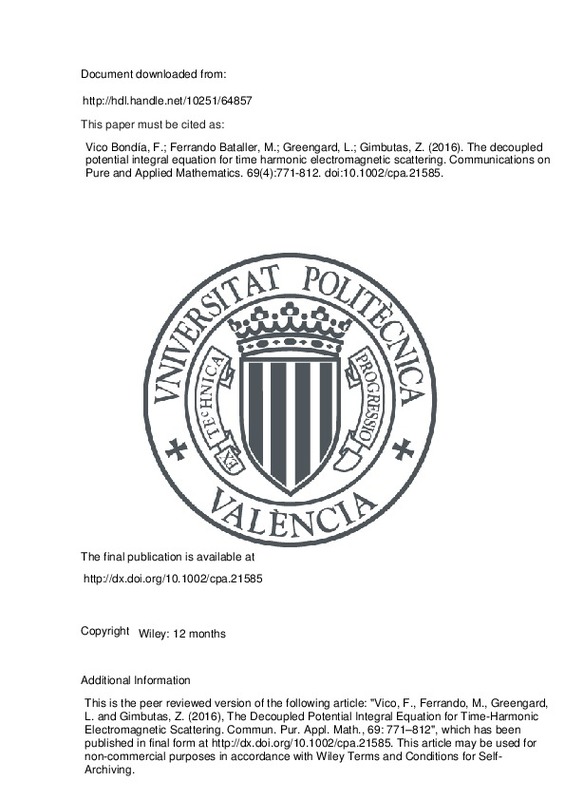JavaScript is disabled for your browser. Some features of this site may not work without it.
Buscar en RiuNet
Listar
Mi cuenta
Estadísticas
Ayuda RiuNet
Admin. UPV
The decoupled potential integral equation for time harmonic electromagnetic scattering
Mostrar el registro sencillo del ítem
Ficheros en el ítem
| dc.contributor.author | Vico Bondía, Felipe
|
es_ES |
| dc.contributor.author | Ferrando Bataller, Miguel
|
es_ES |
| dc.contributor.author | Greengard, Leslie
|
es_ES |
| dc.contributor.author | Gimbutas, Zydrunas
|
es_ES |
| dc.date.accessioned | 2016-05-27T14:35:56Z | |
| dc.date.available | 2016-05-27T14:35:56Z | |
| dc.date.issued | 2016-04 | |
| dc.identifier.issn | 0010-3640 | |
| dc.identifier.uri | http://hdl.handle.net/10251/64857 | |
| dc.description | This is the peer reviewed version of the following article: "Vico, F., Ferrando, M., Greengard, L. and Gimbutas, Z. (2016), The Decoupled Potential Integral Equation for Time-Harmonic Electromagnetic Scattering. Commun. Pur. Appl. Math., 69: 771–812", which has been published in final form at http://dx.doi.org/10.1002/cpa.21585. This article may be used for non-commercial purposes in accordance with Wiley Terms and Conditions for Self-Archiving. | es_ES |
| dc.description.abstract | [EN] We present a new formulation for the problem of electromagnetic scattering from perfect electric conductors. While our representation for the electric and magnetic fields is based on the standard vector and scalar potentials A, phi in the Lorenz gauge, we establish boundary conditions on the potentials themselves rather than on the field quantities. This permits the development of a wellconditioned second-kind Fredholm integral equation that has no spurious resonances, avoids low-frequency breakdown, and is insensitive to the genus of the scatterer. The equations for the vector and scalar potentials are decoupled. That is, the unknown scalar potential defining the scattered field, phi(scat), is determined entirely by the incident scalar potential phi(inc). Likewise, the unknown vector potential defining the scattered field, A scat, is determined entirely by the incident vector potential A(inc). This decoupled formulation is valid not only in the static limit but for arbitrary omega >= 0. (C) 2016 Wiley Periodicals, Inc. | es_ES |
| dc.description.sponsorship | This work was supported in part by the Applied Mathematical Sciences Program of the U.S. Department of Energy under Contract DE-FGO288ER25053 (L.G.), by the Office of the Assistant Secretary of Defense for Research and Engineering and AFOSR under NSSEFF Program Award FA9550-10-1-0180 (L.G. and Z.G.), and in part by the Spanish Ministry of Science and Innovation (Ministerio de Ciencia e Innovacion) under projects CSD2008-00068 and TEC2010-20841-C04-01. The authors thank A. Klockner and M. O'Neil for many useful discussions. | |
| dc.language | Inglés | es_ES |
| dc.publisher | Wiley: 12 months | es_ES |
| dc.relation.ispartof | Communications on Pure and Applied Mathematics | es_ES |
| dc.rights | Reserva de todos los derechos | es_ES |
| dc.subject.classification | TEORIA DE LA SEÑAL Y COMUNICACIONES | es_ES |
| dc.title | The decoupled potential integral equation for time harmonic electromagnetic scattering | es_ES |
| dc.type | Artículo | es_ES |
| dc.identifier.doi | 10.1002/cpa.21585 | |
| dc.relation.projectID | info:eu-repo/grantAgreement/DOE//FG02-88ER25053/ | es_ES |
| dc.relation.projectID | info:eu-repo/grantAgreement/AFOSR//FA9550-10-1-0180/ | es_ES |
| dc.relation.projectID | info:eu-repo/grantAgreement/MICINN//CSD2008-00068/ES/Tecnología de terahercios para aplicaciones de obtención de información mediante sensores electromagnéticos/ | es_ES |
| dc.relation.projectID | info:eu-repo/grantAgreement/MICINN//TEC2010-20841-C04-01/ES/ANTENAS EN LA BANDA DE MILIMETRICAS PARA APLICACIONES INALAMBRICAS DE ALTA VELOCIDAD/ | |
| dc.rights.accessRights | Abierto | es_ES |
| dc.contributor.affiliation | Universitat Politècnica de València. Departamento de Comunicaciones - Departament de Comunicacions | es_ES |
| dc.description.bibliographicCitation | Vico Bondía, F.; Ferrando Bataller, M.; Greengard, L.; Gimbutas, Z. (2016). The decoupled potential integral equation for time harmonic electromagnetic scattering. Communications on Pure and Applied Mathematics. 69(4):771-812. https://doi.org/10.1002/cpa.21585 | es_ES |
| dc.description.accrualMethod | S | es_ES |
| dc.relation.publisherversion | http://dx.doi.org/10.1002/cpa.21585 | es_ES |
| dc.description.upvformatpinicio | 771 | es_ES |
| dc.description.upvformatpfin | 812 | es_ES |
| dc.type.version | info:eu-repo/semantics/publishedVersion | es_ES |
| dc.description.volume | 69 | es_ES |
| dc.description.issue | 4 | es_ES |
| dc.relation.senia | 291570 | es_ES |
| dc.contributor.funder | U.S. Department of Energy | |
| dc.contributor.funder | Ministerio de Ciencia e Innovación | |
| dc.contributor.funder | Air Force Office of Scientific Research |







![[Cerrado]](/themes/UPV/images/candado.png)

